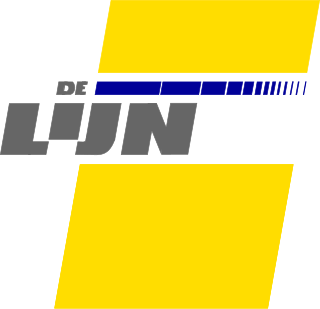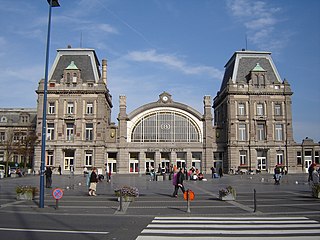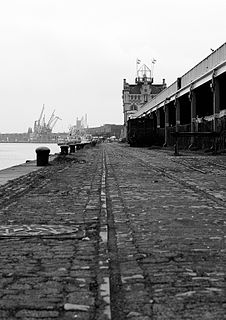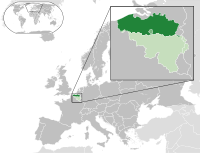
Transport in Belgium is facilitated with well-developed road, air, rail and water networks. The rail network has 2,950 km (1,830 mi) of electrified tracks. There are 118,414 km (73,579 mi) of roads, among which there are 1,747 km (1,086 mi) of motorways, 13,892 km (8,632 mi) of main roads and 102,775 km (63,861 mi) of other paved roads. There is also a well-developed urban rail network in Brussels, Antwerp, Ghent and Charleroi. The ports of Antwerp and Bruges-Zeebrugge are two of the biggest seaports in Europe. Brussels Airport is Belgium's biggest airport.

West Flanders is the westernmost province of the Flemish Region, in Belgium. It is the only coastal Belgian province, facing the North Sea to the north. It has land borders with the Netherlands to the northeast, the Flemish province of East Flanders to the east, the Walloon province of Hainaut in the southeast and France to the west. Its capital is Bruges (Brugge). Other important cities are Kortrijk in the south and Ostend on the coast, Roeselare and Ypres (Ieper). The province has an area of 3,125 km2 which is divided into eight administrative districts (arrondissementen) containing 64 municipalities.

The Flemish Region is one of the three regions of the Kingdom of Belgium—alongside the Walloon Region and the Brussels-Capital Region. Colloquially, it is usually simply referred to as Flanders. It occupies the northern part of Belgium and covers an area of 13,522 km2. It is one of the most densely populated regions of Europe with around 480 inhabitants per square kilometer.

The Coast Tram is a public transport service connecting the cities and towns along the entire Belgian coast, between De Panne near the French border and Knokke-Heist near the Dutch border. At 68 km in length, it is the longest tram line in the world, as well as one of the few interurban tramways in the world to remain in operation. The line is built at 1,000 mmmetre gauge and fully electrified at 600 V DC.

Gent-Sint-Pieters is the main railway station in Ghent, Belgium, and the third-busiest in Belgium, with 17.65 million passengers a year..
Science and technology in Flanders, being the Flemish Community and more specifically the northern region of Belgium (Europe), is well developed with the presence of several universities and research institutes. These are strongly spread over all Flemish cities, from Kortrijk and Bruges in the Western side, over Ghent as a major university center alongside Antwerp, Brussels and Leuven to Hasselt and Diepenbeek in the Eastern side.

Gent-Dampoort is the second largest railway station in Ghent, East Flanders, Belgium. The station opened on 15 June 1861 on the Lines 58 and 59. The train services are operated by NMBS/SNCB.

Station Brugge is the main railway station in Bruges, West Flanders, Belgium. The station opened on 12 August 1838 on the Lines 50A, 51 and 66. The current building has been in use since 1939. The station is one of the busiest in Belgium. Train services are operated by NMBS/SNCB.

Kortrijk railway station is the main railway station in the Belgian city of Kortrijk and one of the busiest railway stations in Belgium. Its NMBS/SNCB internal code is LK. The station was first inaugurated on 22 September 1839.

The Ghent tramway network is a network of tramways forming part of the public transport system in Ghent, a city in the Flemish Region of Belgium, with a total of three lines. Since 1991, the network has been operated by De Lijn, the public transport entity responsible for buses and trams in Flanders.
Brussels has an extensive network of both private or public transportation means. Public transportation includes Brussels buses, trams, the Brussels metro (all three operated by the STIB as well as a set of railway lines and railway stations served by public trains. Bicycle-sharing and car-sharing public systems are also available. Air transport is available via one of the city's two airports, and boat transport is available via the Port of Brussels. The city is relatively car-dependent by northern European standards and is considered to be the most congested city in the world according to the Inrix traffic survey.

Knokke station serves Knokke-Heist and Knokke, in West Flanders, Belgium and was built in 1920. Knokke station is run by NMBS and is a terminal station located on the Belgian railway line 51 B from Brugge railway station and has services to Brussels South and beyond to Tongeren. The Kusttram terminus is located outside the station with trams to Oostende and beyond.

Blankenberge is a railway station in Blankenberge, West Flanders, Belgium. The station opened on 16 August 1863 on the Line 51.

Lokeren is a railway station in the town of Lokeren, East Flanders, Belgium. The station opened on 9 August 1847 and is located on the 57 and 59. The train services are operated by National Railway Company of Belgium (NMBS).

The Bruges–Ostend Canal is a 24.6 km (15.3 mi) long canal in Flanders, Belgium. The canal connects the North Sea to the Belgian interior, running between the cities of Ostend and Bruges. In Bruges, it is connected to three other canals: the Canal Ghent–Bruges, Damme Canal, and Boudewijn Canal which leads to the Port of Zeebrugge. Construction started in 1618, it was finished in 1623.
























